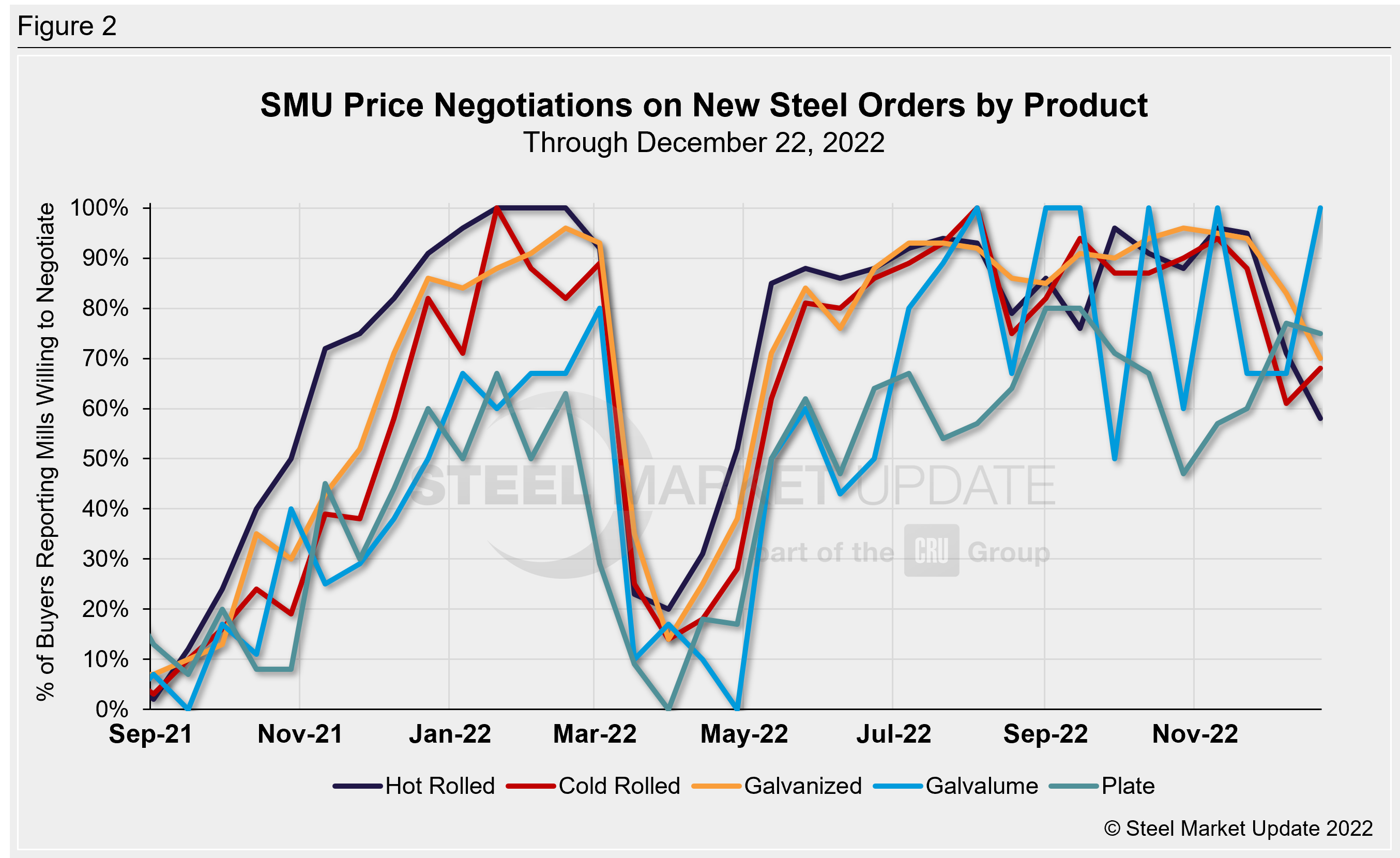Final Thoughts
Steel Mills Less Willing To Negotiate Lower Prices
Written by Brett Linton
December 22, 2022
A significant percentage of steel buyers continue to report that mills willing to negotiate lower prices on new order prices. But that rate has been declining since early November, according to Steel Market Update’s recent market checks. Mills’ willingness to negotiate lower prices for sheet products is at its lowest point since late April, when tags were still elevated because of the shock of war in Ukraine. Negotiation rates on plate products remain slightly higher than sheet products.
Every two weeks, SMU asks hundreds of steel buyers: Are you finding domestic mills willing to negotiate spot pricing on new orders? On average, 67% of steel buyers polled this week reported that mills were willing to talk price on new orders. This is down from an average rate of 73% two weeks ago and down from a rate of 85% one month prior. Six weeks ago, we saw an average negotiation rate of 91%, a ten-month high. As shown in Figure 1, negotiation rates continue to remain relatively high and have been so for nearly eight months.

Figure 2 below shows negotiation rates by various products. This week, 58% of hot rolled buyers responded that mills are willing to negotiate lower prices on new orders. This is down from a rate of 71% two weeks ago. Recall that in early November we saw a rate of 96%, which was one of the highest rates seen since February. The last time hot rolled negotiation rates were this low was in April.
Sixty-eight percent of cold rolled respondents reported that mills were willing to talk price this week. This is up from 61% two weeks ago but down from 88% one month prior.
For galvanized steel buyers, 70% responded that mill prices were negotiable this week, down from 83% two weeks ago. Recall that in late October our galvanized negotiation rate reached 96%, the highest rate recorded in more than eight months. As with hot rolled, the last time we saw galvanized negotiation rates this low was in April.
Galvalume negotiation rates tend to be more volatile due to the smaller market size. All of the buyers we polled this week reported that mills were negotiable on new orders. This is up from a rate of 67% two weeks ago.
Negotiations have been slightly less common in the plate market but ticked up in recent weeks: 75% of buyers reported that mills were willing to negotiate in our latest survey. This is down from 77% recorded two weeks earlier but up from 60% one month ago. Plate negotiation rates were as high as 80% in September. Recall we saw plate negotiation rates between 0–18% in March and April.
SMU’s Price Momentum Indicator was adjusted from Neutral to Higher on Dec. 13 for sheet products, in light of recent mill price hikes and extending lead times. Our plate momentum indicator, in contrast, continues to point Lower.

Note: SMU surveys active steel buyers every other week to gauge the willingness of their steel suppliers to negotiate pricing. The results reflect current steel demand and changing spot pricing trends. SMU provides our members with a number of ways to interact with current and historical data. To see an interactive history of our Steel Mill Negotiations data, visit our website here.
By Brett Linton, Brett@SteelMarketUpdate.com

Brett Linton
Read more from Brett LintonLatest in Final Thoughts

Final Thoughts
Despite some scary headlines lately (especially about Trump potentially firing Fed Chair Jerome Powell) this is not October 2008 (financial crisis) or March 2020 (onset of the pandemic). But it sure seems like we’ve taken a relatively strong economy and poured a thick sauce of uncertainty over it.

Final Thoughts
I put some of our survey data through ChatGpt, with interesting results.

Final Thoughts
Nearly 50% of respondents to our latest survey thought hot-rolled coil prices have already peaked. And where will those prices be two months from now? Responses were decidedly split on that question.

Final Thoughts
A modest week-to-week change in HR price understates a huge swing in expectations.

Final Thoughts
What happens when ChatGPT meets SMU's Market Chatter? No, this is not an idea for the latest Hollywood blockbuster. Then again, with what Hollywood is putting out these days, Chatter Meets Chat might just turn out to be a hit. Rather, it’s that old idea of putting theory into practice. Recently, I conducted an interview with Doug Schrock, managing principal of AI at public accounting and consulting firm Crowe. He gave some tips on how to implement AI into your business.
